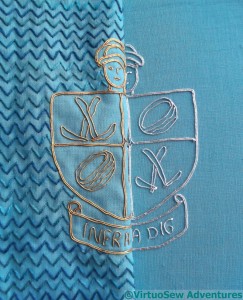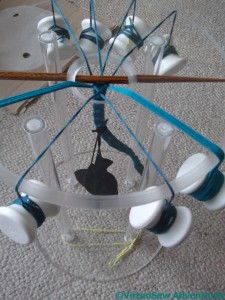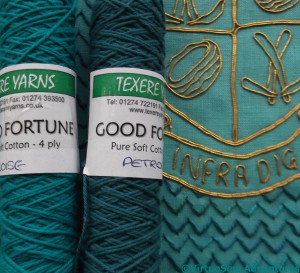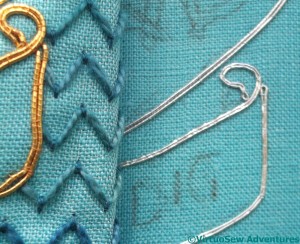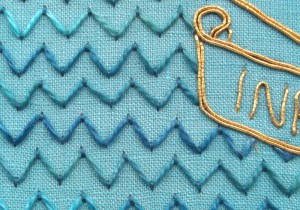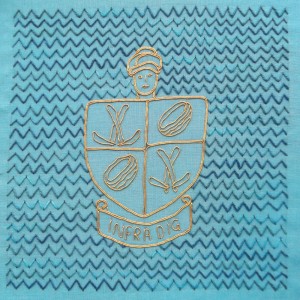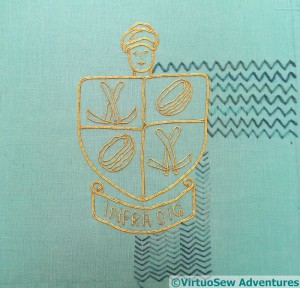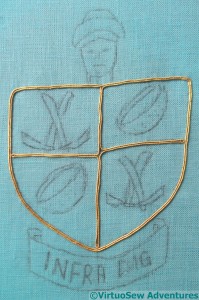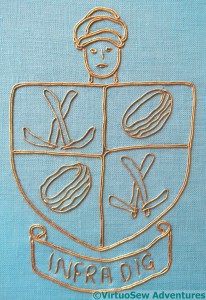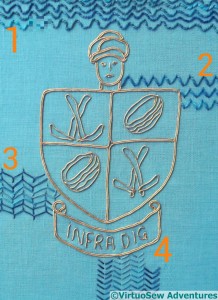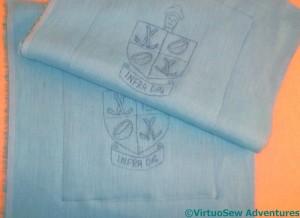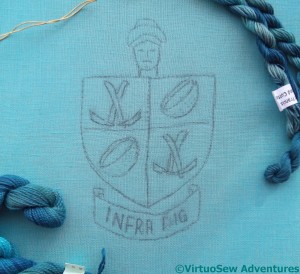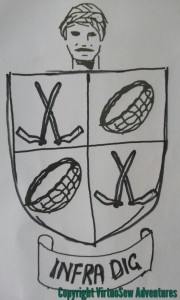Tag: The Crest for the Dig
The Second Crest for the Dig
Last month, I had made several unsatisfactory trials with silver thread, and took my headaches to the Harrogate Knitting and Stitching Show to ask advice on the Golden Hinde stand.
I got to the show with about 40 minutes to go of the Thursday evening late opening, which meant that the aisles were relatively clear and I could actually talk to Sarah. After some discussion, we came up with a very bright and blingy silver Jap. In fact it’s so bright and blingy as to be verging on mirrored, and I was surprised at quite how calm it looked when I finished it.
The reason it is so bright is that the metallic wrapping film is much broader than it was on any of the other silver threads I tried. That carries its’ own penalty, because turning corners becomes trickier – and indeed, in a few cases, rather untidier (click on the picture to enlarge it and look at a few of the corners!). I found that I had to devise new pathways for the couching, and use more short lengths. This panel is markedly more fluffy on the back than the gold one was!
I just have miles of that cloud filling stitch variation to do now (and, of course, choose and apply the braided edging!). The background stitching will help to throw the silver crest into relief. I have laid the completed gold over the silver so that you can see. With decent lighting, it should have enough personality to hold its corner.
If it doesn’t, I will frame it up as a separate panel, and show people just how difficult it was!
Experiments with A Marudai
I’ve been fascinated by Kumihimo braiding for ages. I first heard about it many years ago from a mathematician friend of my husband’s. Quite why, I can’t now recall, unless it was a desperate attempt on the part of the mathematician to find something textile-related to talk to me about.
Jolly decent of him, don’t you think? He certainly had no idea what he was starting..
Anyway, I’ve heard a lot about it, and rather like the effects that can be obtained. In the UK, the best source for information and equipment is Jacquie Carey at The Carey Company. Jacquie has also become better known to historical embroiderers because while she was researching historical braids she became fascinated by the stitches in them, and besides her books on Braiding, she has now written books about Elizabethan Stitches (remember my experiments with some of them for the Glittering Nightcap?), and Sweet Bags!
I’ve bought myself an acrylic marudai and bobbins, and spent a fascinating – not to say, bewildering! – couple of hours at Texere Yarns in Bradford, trying to find some suitable yarns to experiment with.
Since my initial aim is to create a braid edging for the Crest for the Dig, I began by finding some cotton knitting yarns that seem to go very nicely with the panels, as well as a whole load of extra yarns for additional experiments.
Then I started playing…!
A Dilemma
Now, you may recall from when I began the first one that there are to be two Crests, one for each panel, balancing each other. Furthermore, since there will be a gauze overlay, everything has to have the visual strength to show through it.
I don’t think that this silver thread has enough force or shine. Even with a fairly strong background using my Cloud Filling variation, to throw it into relief, it will simply disappear.
So I have been experimenting. The edge of the shield, the top of the scroll, and the bottom of the scroll, all use different threads.
All of them are equally insipid in comparison with the gold. I’m afraid that if I use any of these threads for the panel, I will end up with an unbalanced overall appearance with one corner panel seeming very faded in comparison with the other.
I hope to find a more suitable thread at the Harrogate Knitting and Stitching Show this week. Or alternatively – more of the gold so I can do a second gold one!
The First Crest for The Dig – Finished
The Cloud Filling Stitch variation that creates the ripple effect is fairly easy to do, and once I had decided to get working on it, finishing the first panel really ripped along.
As you see, I’ve not been too pernickety about spacing. It would have been possible, but it wouldn’t have been in keeping with the original inspiration, besides being utterly maddening to achieve.
I began by working each row individually, first the short stitches and then threading the pearl cotton, but I soon found that it was much quicker to do several rows of the holding stitches, and then threading the pearl cotton through them.
So here it is, done. The other crest panel, when I get to it, will be in silver, with the same background. I need to get the other piece of fabric onto the frame and get ready, because it is good to have at least one project in which I know exactly what I want to do.
There is one question that remains to be solved – how will I edge each panel? I’ve been thinking about lucetting, crochet, or kumihimo. I have a feeling that a lot of experimentation lies in my future.
Progress on the Crest for the Dig
The goldwork on the Crest for the Dig went rather quickly, and I found myself running straight into a brick wall. I narrowed my background choices down to two, and then stopped. I’ve even extended the patches of trial background, and propped the frame up to stare at.
The arrowhead stitches create a subtle effect; patchy ripples, almost here-and-then-gone-again. Rather like Amarna, in fact – it’s thought the city was inhabited for less than thirty years.
On the other hand, the pearl cotton cloud stitch variation is more reminiscent of the rippling paint pattern that originally inspired me. The variegated thread helps to stop the background pattern from being too solid and monolithic.
Choices, choices….
In fact I took the frame to my parents’ house, last time I visited, and said plaintively “Help!”
We stared at it, talked about it, and finally decided that the pearl cotton variation on Cloud Filling Stitch is the way to go. It’s more in keeping with the idea of the doodle that inspired this design, the thread is closer in scale to the scale of the gold thread, and it’s also a better reflection of the ripple pattern I want to bring to mind.
I’m also considering how I’m going to edge the panel of stitching. At the moment, my ideas include lucetted cord or a flat kumihimo braid. The lucetted braid might be too narrow, but on the other hand I’ve only ever done one piece of kumihimo braid, so that would be rather a leap into the unknown!
Continuing The Crest for the Dig
The sensible first stage for the Crest was to do the goldwork. First of all, I’m not at all sure how I am going to do the background, so I should concentrate on the bit I’ve decided on. Secondly, I was a little worried that I might not have enough gold thread of the type I wanted to use…
That being the case, I decided that rather than giving each line a stop and a start, I would try to keep the lines going. That has meant a lot of thinking had to go into getting all the double lines right, and a bit of a fiddle at the central crossing point!
In the interests of both contrast and economy, the charges – motifs, in non-heraldic language – and the motto will use only one line of gold, but the shield, the Gufti’s head, and the scroll will use double rows to help pull it out from the background.
The goldwork of the Gufti’s head doesn’t have quite the same sense of life as my original sketch, but I am very pleased with how the folds of the turban turned out.
The charges – crossed touriehs (mattocks) and rush baskets (used to carry the spoil away) – have turned out well too. I was concerned that I might need to create a woven effect on the baskets, but now I look at the finished goldwork, I think it is enough to create the effect I am looking for.
The motto is a little uneven, but after all, it recalls Pendlebury just doodling something over dinner, and while drawing and sketching were vital skills for archaeologists – in fact they still are – I doubt he would have put the care into a doodle that he put into recording a trench!
That didn’t take very long, did it. Suddenly I realise that I should have thought it out a bit better before I started. There’s a rippling pattern sometimes seen on plaster which I would like to recall in the background. It’s a simple pattern, but I think it could be effective – if I can get it right. In order, the trials I have done here show:
1 – Variegated Pearl cotton following a ricrac “stencil”, couched as invisibly as possible using a single strand of stranded cotton.
2 – Variegated Pearl cotton in a variation of cloud filling stitch that creates a ripple effect instead of the usual diamond pattern.
3 – Variegated Stranded cotton in rows of open cretan stitch, using three strands.
4 – Variegated Stranded cotton in Arrowhead Stitch.
I’ve discounted the first and third possibilities, but I’m still staring thoughtfully at the other two.
The Crest For The Dig – Making a Start
Some time ago I started to work on a design for my version of the crest that John Pendlebury doodled for the dig on the first night after the expedition arrived. It was to be the corner design for one of the panel assemblies, matched by I’m-not-sure-what in the other corner.
In the process of my recent replanning, the corner design turned into twins – there will be one for each panel. The design has also become less spare. I am planning – as originally – to work all the lines in couched metal thread (one silver, one gold), but instead of leaving the background plain I am now intending to couch or stitch a background of spaced rows of wavy lines. Some of the small fragments of painted plaster from Amarna show such a pattern, and it will create some texture and density in the corners of the finished panels.
I am using the remains of the gold thread I used for Christus Natus Est, but I’m still not sure what thread to use for the background. By the time I took this photograph I had already decided that I was going to choose a matte thread for the couching. This will help to bring the gold forward.
I had also already decided to use a variegated thread. The wavy pattern usually alternates rows of dark and light, but in this case I hope that the fabric will provide the light and the variations of colour across the background will give a sense of movement and “flow”. The couched metal thread will be very static and stiff, and without some sense of flow somewhere, the whole thing will look a bit pedestrian.
I have yet to make a decision here. The choice, unless I find some other thread which appeals even more, is between a pearl cotton and a stranded cotton. They are both from Stef Francis, and both are in the same colour sequence. I hope that when I have the gold done, the answer will come to me!
Dreams of Amarna – a Crest for the dig
Mary Chubb recounts in “Nefertiti Lived Here” that on the first evening that they were at Amarna, John Pendlebury doodled a coat of arms for the dig. She tells us that he had something of an enthusiasm for the medieval period, and when I was a teenager I was rather a heraldry enthusiast myself, so that little story struck a real chord.
The key elements in a coat of arms are the shield, the crest, and the motto.
The crest was a Gufti’s head. The Guftis were expert excavators and overseers, people from a particular village, originally trained in excavation techniques by Flinders Petrie, who passed on the knowledge and the career from father to son. As I discovered in the BBC4 programme about Petrie, “The Man Who Discovered Egypt“, the Guftis are still in demand in Egyptian archaeology today, which is very good to know.
The motto – suggested by Mary herself – is “Infra Dig”, which I take as a very bad pun. They’ll be digging below the surface, of course, but the term would more usually be taken to mean something like “Beneath Our Dignity”.
On the shield, first and third quarterly, Pendlebury placed crossed touriehs. The tourieh was a sort of mattock, used to pull back the sand into a basket propped up against the digger’s legs. Second and fourth quarterly, he placed a basket.
Eventually I intend to stitch the crest design in couched gold onto one of the dark teal corner panels. As it is such a simple design it would be a good one to do while I’m planning something else, but unfortunately I’ve not quite worked out what size I want it to be!
I’ve prepared my sketch using drawing apps on my tablet, and I’m really quite pleased with the result. Although I have moments in watercolour that are really successful, I’m not as good with line as with form, and the Gufti’s head, drawn from one of the photos the Egypt Exploration Society provided, turned out much better than I expected!


